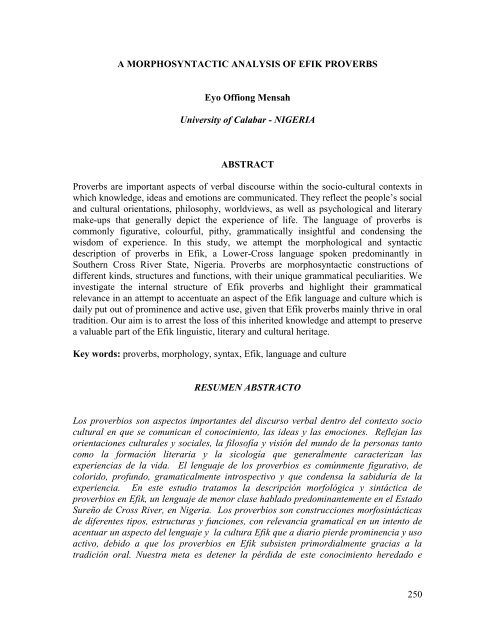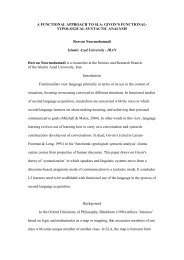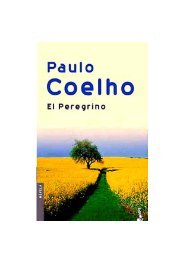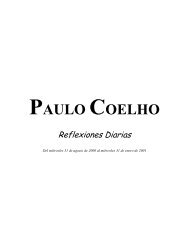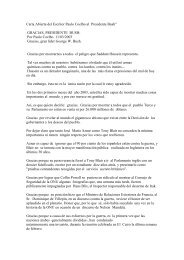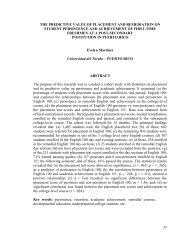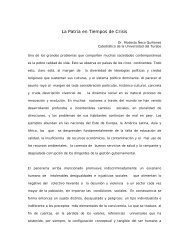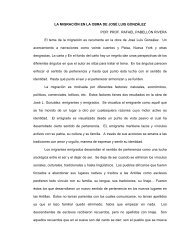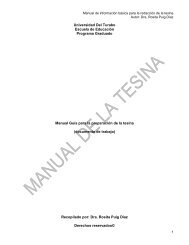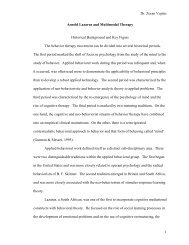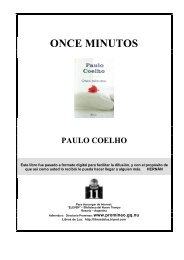A Morphosyntactic Analysis of Efik Proverbs - Biblioteca virtual de la ...
A Morphosyntactic Analysis of Efik Proverbs - Biblioteca virtual de la ...
A Morphosyntactic Analysis of Efik Proverbs - Biblioteca virtual de la ...
Create successful ePaper yourself
Turn your PDF publications into a flip-book with our unique Google optimized e-Paper software.
A MORPHOSYNTACTIC ANALYSIS OF EFIK PROVERBS<br />
Eyo Offiong Mensah<br />
University <strong>of</strong> Ca<strong>la</strong>bar - NIGERIA<br />
ABSTRACT<br />
<strong>Proverbs</strong> are important aspects <strong>of</strong> verbal discourse within the socio-cultural contexts in<br />
which knowledge, i<strong>de</strong>as and emotions are communicated. They reflect the people‟s social<br />
and cultural orientations, philosophy, worldviews, as well as psychological and literary<br />
make-ups that generally <strong>de</strong>pict the experience <strong>of</strong> life. The <strong>la</strong>nguage <strong>of</strong> proverbs is<br />
commonly figurative, colourful, pithy, grammatically insightful and con<strong>de</strong>nsing the<br />
wisdom <strong>of</strong> experience. In this study, we attempt the morphological and syntactic<br />
<strong>de</strong>scription <strong>of</strong> proverbs in <strong>Efik</strong>, a Lower-Cross <strong>la</strong>nguage spoken predominantly in<br />
Southern Cross River State, Nigeria. <strong>Proverbs</strong> are morphosyntactic constructions <strong>of</strong><br />
different kinds, structures and functions, with their unique grammatical peculiarities. We<br />
investigate the internal structure <strong>of</strong> <strong>Efik</strong> proverbs and highlight their grammatical<br />
relevance in an attempt to accentuate an aspect <strong>of</strong> the <strong>Efik</strong> <strong>la</strong>nguage and culture which is<br />
daily put out <strong>of</strong> prominence and active use, given that <strong>Efik</strong> proverbs mainly thrive in oral<br />
tradition. Our aim is to arrest the loss <strong>of</strong> this inherited knowledge and attempt to preserve<br />
a valuable part <strong>of</strong> the <strong>Efik</strong> linguistic, literary and cultural heritage.<br />
Key words: proverbs, morphology, syntax, <strong>Efik</strong>, <strong>la</strong>nguage and culture<br />
RESUMEN ABSTRACTO<br />
Los proverbios son aspectos importantes <strong>de</strong>l discurso verbal <strong>de</strong>ntro <strong>de</strong>l contexto socio<br />
cultural en que se comunican el conocimiento, <strong>la</strong>s i<strong>de</strong>as y <strong>la</strong>s emociones. Reflejan <strong>la</strong>s<br />
orientaciones culturales y sociales, <strong>la</strong> filos<strong>of</strong>ía y visión <strong>de</strong>l mundo <strong>de</strong> <strong>la</strong> personas tanto<br />
como <strong>la</strong> formación literaria y <strong>la</strong> sicología que generalmente caracterizan <strong>la</strong>s<br />
experiencias <strong>de</strong> <strong>la</strong> vida. El lenguaje <strong>de</strong> los proverbios es comúnmente figurativo, <strong>de</strong><br />
colorido, pr<strong>of</strong>undo, gramaticalmente introspectivo y que con<strong>de</strong>nsa <strong>la</strong> sabiduría <strong>de</strong> <strong>la</strong><br />
experiencia. En este estudio tratamos <strong>la</strong> <strong>de</strong>scripción morfológica y sintáctica <strong>de</strong><br />
proverbios en <strong>Efik</strong>, un lenguaje <strong>de</strong> menor c<strong>la</strong>se hab<strong>la</strong>do predominantemente en el Estado<br />
Sureño <strong>de</strong> Cross River, en Nigeria. Los proverbios son construcciones morfosintácticas<br />
<strong>de</strong> diferentes tipos, estructuras y funciones, con relevancia gramatical en un intento <strong>de</strong><br />
acentuar un aspecto <strong>de</strong>l lenguaje y <strong>la</strong> cultura <strong>Efik</strong> que a diario pier<strong>de</strong> prominencia y uso<br />
activo, <strong>de</strong>bido a que los proverbios en <strong>Efik</strong> subsisten primordialmente gracias a <strong>la</strong><br />
tradición oral. Nuestra meta es <strong>de</strong>tener <strong>la</strong> pérdida <strong>de</strong> este conocimiento heredado e<br />
250
intentar preservar una valiosa parte <strong>de</strong> <strong>la</strong> literatura y herencia cultural <strong>de</strong> <strong>la</strong> lingüística<br />
<strong>Efik</strong>.<br />
Pa<strong>la</strong>bras c<strong>la</strong>ve: Proverbios, sintaxis, <strong>Efik</strong>, lenguaje y cultura<br />
Eyo Offiong Mensah is a lecturer in the Department <strong>of</strong> Linguistics and Communication<br />
Studies, University <strong>of</strong> Ca<strong>la</strong>bar, Nigeria. His areas <strong>of</strong> research are Morphology, Syntax,<br />
Sociolinguistics and African Linguistics (<strong>Efik</strong>). He is a Fellow <strong>of</strong> the African Humanities<br />
Programme and the American Council <strong>of</strong> Learned Societies.<br />
Introduction<br />
<strong>Proverbs</strong> are constructed out <strong>of</strong> strings <strong>of</strong> words and affixes that exist in a<br />
<strong>la</strong>nguage, and hence constitute higher grammatical units than phrases, c<strong>la</strong>uses and<br />
sentences. Salzmann (1998) maintains that proverbs are pithy saying that contain<br />
generally accepted truth. According to him, “…it is the voice <strong>of</strong> the old-age authority and<br />
collective wisdom <strong>of</strong> a particu<strong>la</strong>r society” (p. 261). In other words, it is not the user <strong>of</strong> the<br />
proverbs who speaks but the experience <strong>of</strong> the many generations that have gone before.<br />
In this way, the use <strong>of</strong> proverbs remains a veritable tool for traditional education and the<br />
transmission <strong>of</strong> social, cultural, and historical values and information. The use <strong>of</strong><br />
proverbs perva<strong>de</strong>s all facets <strong>of</strong> human activities and perception, and as Andah (1982)<br />
p<strong>of</strong>fers, “…it‟s a major <strong>de</strong>terminant <strong>of</strong> the images with which people face one another<br />
and all the problems <strong>of</strong> life” (p. 3). Our traditional lea<strong>de</strong>rs <strong>of</strong> thoughts, and men <strong>of</strong><br />
wisdom, use proverbs as a form <strong>of</strong> literary expression to warn, encourage, admonish,<br />
mock, advise, console and generally establish the verbal convention that is significant to<br />
the social or<strong>de</strong>r, given some social, cultural and historical circumstances. Unfortunately,<br />
these values are fast disappearing as they are no longer being transmitted to the present<br />
251
generation. In this way, an enriching aspect <strong>of</strong> the <strong>Efik</strong> (and by extension African<br />
<strong>la</strong>nguages) is facing a crisis <strong>of</strong> extinction.<br />
Although Salzmann (1998) has conten<strong>de</strong>d that “…the substance <strong>of</strong> a proverb does<br />
not lie in its style or syntax but the message it communicates” (p. 261). We argue that the<br />
message cannot be iso<strong>la</strong>ted from the style and syntax because they give expression to and<br />
endow the proverb with its essential character. The grammatical <strong>de</strong>scription <strong>of</strong> <strong>Efik</strong><br />
proverbs has long been ignored in the few studies on <strong>Efik</strong> proverbs. Our c<strong>la</strong>im in this<br />
paper is that <strong>Efik</strong> proverbs contain enormous morphosyntactic information which is<br />
invaluable in giving significant insights into the native speaker‟s grammar. This study<br />
aims to encourage the promotion and sustenance <strong>of</strong> a part <strong>of</strong> the <strong>Efik</strong> linguistic legacy<br />
given the challenges <strong>of</strong> global communication. In the discussion that follows, we examine<br />
the typology <strong>of</strong> <strong>Efik</strong> proverbs.<br />
Typology <strong>of</strong> <strong>Efik</strong> <strong>Proverbs</strong><br />
In this study, we categorize <strong>Efik</strong> proverbs into two broad c<strong>la</strong>sses: the proverbriddle<br />
and the conventional proverb. According to Umoh (2007), proverb-riddle is<br />
analogous to a coin with two faces. It is a two part saying which combines the attribute <strong>of</strong><br />
both the riddle and proverb. Salzmann (1998) argues that proverb-riddles are<br />
…puzzling questions based on some unexpected connections with a solution that<br />
is to be guessed. They serve as a good example <strong>of</strong> oral folklore that is constantly<br />
renewing itself. They are favourite form <strong>of</strong> entertainment between teams <strong>of</strong><br />
individuals, both young and adult. (p. 261)<br />
In <strong>Efik</strong>, this form <strong>of</strong> genre is usually employed in story-telling and moonlight<br />
p<strong>la</strong>ys. It is used to spice the story in the beginning, intermittently and at the end <strong>of</strong> the<br />
252
narration. Every proverb-riddle, just like a main story begins with a call by the narrator or<br />
any member <strong>of</strong> the audience and a general response by the audience, <strong>of</strong> the traditional<br />
formu<strong>la</strong>e:<br />
1(a) call:<br />
(b) response:<br />
Ékọñ ńké-éé<br />
Ñké ékọñ àbàsì<br />
As an opening formu<strong>la</strong>, it is a formal courtesy by the narrator <strong>of</strong> a story to use it<br />
to draw every listener‟s attention and evoke an air <strong>of</strong> calmness. It is re-echoed at regu<strong>la</strong>r<br />
intervals to obtain attention, concentration and participation. Examples <strong>of</strong> proverb-riddles<br />
in <strong>Efik</strong> inclu<strong>de</strong>:<br />
2(a) riddle: Ọ-dúọk ńtọñ ké ńtọñ é-tiènè.<br />
3-SG pour ashe Aux ashe 3SG-follow<br />
„He who pours ashes is followed by the same ashes‟<br />
(b) answer: Á- súá éyèn ówó í-nyéné-ké ésìé.<br />
3SG hate child person 3SG-has-NEG his<br />
„He who hates another person‟s child is childless‟<br />
3(a) riddle:<br />
Ń-tém ńtém mbèn úsùñ ń-kpì ébót ókpó.<br />
1SG-cut grass si<strong>de</strong> road 1SG-stab goat bone<br />
„I <strong>la</strong>boured by the si<strong>de</strong> <strong>of</strong> the road and cut the goat‟s leg‟<br />
(b) answer: Ń- díá údíá úfọk ówò ń- sìn útóm ń-dí-nám<br />
1SG-eat food house person 1SG refuse work 1SG-PAST- do<br />
„I ate someone‟s food and refused to participate in his work‟<br />
Children are taught and brought up through a social learning process by this folk<br />
culture. The structure <strong>of</strong> <strong>Efik</strong> proverb-riddles generally reflects a cause-and-effect<br />
re<strong>la</strong>tionship, putting people at the centre <strong>of</strong> its focus and emphasizing values and value<br />
systems. These proverb-riddles just like other forms <strong>of</strong> oral literary genres in <strong>Efik</strong> are<br />
253
poetic and rhythmic. This is because the tune <strong>of</strong> the answer is based on the tone and<br />
rhythm <strong>of</strong> the riddle. Importantly, the syl<strong>la</strong>bles <strong>of</strong> the answer correspond to the syl<strong>la</strong>bles<br />
<strong>of</strong> the riddle.<br />
The type <strong>of</strong> <strong>la</strong>nguage use in proverb-riddles, according to Salzmann (1998)<br />
sharpens the wits <strong>of</strong> children and helps them to explore various aspects <strong>of</strong> the vocabu<strong>la</strong>ry<br />
and the cognitive co<strong>de</strong> <strong>of</strong> the mother tongue. This implies that proverb-riddles can<br />
enhance the child‟s ability to speak his <strong>la</strong>nguage accurately, automatically and creatively<br />
by being able to i<strong>de</strong>ntify and integrate properly with his <strong>la</strong>nguage community. Umoh<br />
(2007) has also opined that proverb-riddles can provi<strong>de</strong> raw materials for <strong>la</strong>nguage<br />
teaching. Children can attain mastery <strong>of</strong> a <strong>la</strong>nguage with such verbal duels.<br />
On the other hand, we <strong>de</strong>scribe conventional proverbs as those that are common<br />
in everyday conversational experience. The meaning may be expressed literarily,<br />
philosophically or metaphorically. Unlike the proverb-riddles, conventional proverbs do<br />
not require the use <strong>of</strong> puzzles that need to be unraveled. The basic tenet <strong>of</strong> this medium<br />
lies in the expression <strong>of</strong> meaning within a given social intercourse. Again, the context <strong>of</strong><br />
its application is wi<strong>de</strong>-ranging unlike the proverb-riddle that is restricted to story telling<br />
or moonlight p<strong>la</strong>ys (mbrĕ ọfiọñ). Within the <strong>Efik</strong> socio-cultural contexts, proverb-riddle<br />
is seen as a property <strong>of</strong> children, while conventional proverbs are the preserve <strong>of</strong> the<br />
el<strong>de</strong>rs. This is because only el<strong>de</strong>rs are permitted by social convention to use proverbs in<br />
both formal and non-formal settings. Children can only learn but cannot utilize proverbs<br />
while conversing with el<strong>de</strong>rs.<br />
254
In this study, we focus mainly on the structure <strong>of</strong> the conventional proverbs since<br />
they are found to be grammatically rich and informative. In the discussion that follows,<br />
we examine some features <strong>of</strong> <strong>Efik</strong> proverbs.<br />
Features <strong>of</strong> <strong>Efik</strong> <strong>Proverbs</strong><br />
In this section, we i<strong>de</strong>ntify the stylistic features that are commonly associated<br />
with <strong>Efik</strong> proverbs, and which gives it its distinctiveness. <strong>Proverbs</strong> are usually expressed<br />
in short, succinct and clear <strong>la</strong>nguage, whose meanings may be transparent or opaque:<br />
4(a)<br />
(b)<br />
(c)<br />
Ímá édí óbìó.<br />
love aux nation<br />
„Love makes a nation‟<br />
Ókúk édí àkpàráwà.<br />
money aux youth<br />
„Money makes a man‟<br />
Ówó édí ínyéné<br />
person aux wealth<br />
„(Having) people constitute wealth‟<br />
These proverbs generally embody universal truth and “…imaginable rules and<br />
regu<strong>la</strong>tions consi<strong>de</strong>red by the society as necessary for its continued existence as a<br />
functioning unit” (Andah, 1982, p. 3). They use metaphors to e<strong>la</strong>borate their contents.<br />
Meaning is groun<strong>de</strong>d to reality through the embodied experience <strong>of</strong> human beings. The<br />
concepts <strong>of</strong> love, money and people are pervasive and very central in <strong>de</strong>fining the mindset<br />
<strong>of</strong> an average <strong>Efik</strong> person, and so are given unique metaphorical pr<strong>of</strong>ile here which has<br />
cultural relevance. The vocabu<strong>la</strong>ry <strong>of</strong> proverbs is typically poetic, making use <strong>of</strong> rhyme,<br />
rhythm and sound-symbolism to create the <strong>de</strong>sired effect:<br />
255
5(a)<br />
Ówó á- kpá ké mmọñ,<br />
person 3SG-die in water<br />
ọ-nwọñ mmọñ<br />
3SG-drink water<br />
„If someone drowns, he drinks water‟<br />
(b) Ówó á- tíát úkót ọ- nọ éfík, éfík ó- kpón<br />
person 3SG-open leg 3SG-give hynia hynia 3SG-expand<br />
„If someone opens his leg for hynia, the ailment expands.<br />
In 5(a), the rhyme pattern is used to symbolize a physical notion mmọñ<br />
„water/river‟, which contributes to the overall effect. In (b), a network <strong>of</strong> association is<br />
built by the repetition <strong>of</strong> the word éfík „hynia‟ at different points, which are formally<br />
linked to achieve aesthetic effect, sometimes to compel a listener to consi<strong>de</strong>r their<br />
possible meaning re<strong>la</strong>tions (Crystal, 1997, p. 74).<br />
The use <strong>of</strong> poetic diction and vivid images are other poetic characteristics <strong>of</strong> <strong>Efik</strong><br />
proverbs. These are grandiose, elevated and unfamiliar <strong>la</strong>nguage, which are not common<br />
in everyday discourse:<br />
6. Érén òwò í- trĕ -ké brùsái<br />
Man person 3SG-stop-NEG flirt<br />
„A man cannot stop flirting‟<br />
Webster (1996) maintains that the use <strong>of</strong> poetic diction is an attempt to fix<br />
<strong>la</strong>nguage through a vocabu<strong>la</strong>ry which results in a closed and eventual stale form <strong>of</strong><br />
writing. They are read and un<strong>de</strong>rstood according to historical relevance. The use <strong>of</strong><br />
brusai (an archaic form for „flirt‟) is no longer attestable in mo<strong>de</strong>rn <strong>Efik</strong> vocabu<strong>la</strong>ry but<br />
because <strong>la</strong>nguages change in the course <strong>of</strong> their <strong>de</strong>velopment, certain vocabu<strong>la</strong>ries also<br />
change through history. Webster (1996) further believes that such vocabu<strong>la</strong>ries, which<br />
256
are outsi<strong>de</strong> the margins <strong>of</strong> conventional discourse push meaning to its limit in a particu<strong>la</strong>r<br />
historical moment, thus shifting the signifier towards a new signified.<br />
<strong>Efik</strong> proverbs can be divi<strong>de</strong>d into two parts that ba<strong>la</strong>nce each other, <strong>of</strong>ten<br />
disp<strong>la</strong>ying parallel syntax and rhythm, and links <strong>of</strong> rhyme and alliteration (Crystal, 1996):<br />
7(a) E- da ifiọk e- men nnunuñ koro nnunuñ a- da ifiọk o- dobi<br />
3PL-use skill 3PL-carry mangrove CONJ mangrove 3SG-use skill 3SG-heavy<br />
„It is skills that is used to carry the log <strong>of</strong> mangrove because it uses skills to be<br />
heavy‟<br />
(b)<br />
Kpúkprú ùsèn é- nyènè ínọ úsèn kíét é-nyènè ényéné ínwáñ<br />
every day 3SG-have thief day one 3SG-have owner farm<br />
„Everyday is for the thief. One day is for the owner <strong>of</strong> the farm‟.<br />
In 7(a), the two parts <strong>of</strong> the proverb are joined together by a subordinator kórò<br />
„because‟ implying that they are both subordinate c<strong>la</strong>uses <strong>of</strong> a complex sentence. In (b),<br />
the expressions are clearly two simple sentences. <strong>Efik</strong> uses tonal features to alternate<br />
c<strong>la</strong>sses <strong>of</strong> even and changing tones, and also organize the words into rhymical units. In<br />
the examples above, we observe that some words are repeated to achieve some phonetic<br />
or phonological effects. The use <strong>of</strong> simile and metaphor is a major stylistic feature <strong>of</strong> <strong>Efik</strong><br />
proverbs:<br />
8(a)<br />
(b)<br />
Sóp ntè ídàñ, nyọnì ntè ékwòñ<br />
fast as arrow <strong>de</strong><strong>la</strong>y as snail<br />
„Be as fast as the arrow or be as slow as the snail‟<br />
A-kan eka okukip esio<br />
3SG-win mother cover pot<br />
„A pot cover that is mightier than its (containing) pot<br />
257
The example in 8(a) uses simile to establish contrast <strong>of</strong> movement <strong>of</strong> two objects<br />
that are essentially different. The speed <strong>of</strong> the arrow is contrasted with the slowness <strong>of</strong><br />
the snail to create certain structural foregrounding. In (b), an object has been applied to<br />
another creating an effect <strong>of</strong> sameness that is not literally applicable. A cover <strong>of</strong> a pot is<br />
said to be greater that the pot it is meant to cover. This is clearly a metaphorical effect.<br />
The use <strong>of</strong> pun or word p<strong>la</strong>y is also a poetic feature <strong>of</strong> <strong>Efik</strong> proverbs:<br />
9(a) Ófọñ ọfiọñ ọ- fọn ké ọfiọñ<br />
cloth moon 3SG-good for moon<br />
„The moonlight dress is only suited for moonlight (season).<br />
(b) É-kébé úkébé ọ- tọrọ ùkébè ésìé<br />
3SG-inject enema 3SG-porch enema his<br />
„What one takes as purge is what is excreted‟.<br />
In the examples above, phonetic mix ups and linguistic creativity which are entertaining<br />
and amazing, are employed as a way <strong>of</strong> reinforcing meaning in the proverbs.<br />
The Morphology <strong>of</strong> <strong>Efik</strong> <strong>Proverbs</strong><br />
Words that exist in a <strong>la</strong>nguage consist <strong>of</strong> elements known as morphemes, the<br />
minimal meaning unit <strong>of</strong> meaning or grammatical function (Yule, 1991). Morphemes are<br />
principally free or bound. Free morphemes contain core elements <strong>of</strong> meaning because<br />
they can stand on their own and make sense. Bound morphemes on the other hand, do not<br />
have in<strong>de</strong>pen<strong>de</strong>nt existence. They have semantic content only in the context <strong>of</strong> free<br />
morphemes, and are concerned with grammatical processes which signal categories such<br />
as tense, aspect, mood, person, number and negation. Such bound morphemes are said to<br />
be inflectional while those that signal the creation <strong>of</strong> new words from existing ones are<br />
258
<strong>de</strong>rivational morphemes. We have morphs when morphemes are realized phonetically or<br />
phonologically.<br />
<strong>Efik</strong> proverbs have a rich system <strong>of</strong> inflection as exemplified by the inflectional<br />
capabilities <strong>of</strong> concord affixes in signaling the various verbal categories in re<strong>la</strong>tion with<br />
the root verb:<br />
10(a) Éyén ké é- brĕ yé èkà ntè í- dí- túá -há túá<br />
child AUX 3SG p<strong>la</strong>y PREP mother like 3SG FUT cry NEG EMP<br />
„The child is p<strong>la</strong>ying with his mother as if he will not cry‟<br />
(b) Sé ákámbá ówò é- tié dé tié ó- kút, éyénọwọñ í- dá -há dá í-<br />
kút<br />
what big person 3SG sit ES EMP 3SG see child 3SG stand NEG EMP<br />
3SG see<br />
„The thing an el<strong>de</strong>r sits down to see cannot be seen by a child who is standing‟.<br />
The constituent í- dí- túá -há túá „He will not cry (cry emphasized)‟ in 10(a)<br />
and é- tié -dé tié „He sits down (sit emphasized)‟ as well as í- dá -há dá „He cannot<br />
stand (stand emphasized) in 10(b) are agglutinative in nature. This means that they are<br />
long polymorphic words in which each morpheme corresponds to a single lexical<br />
meaning or grammatical function (Spencer, 1991). They consist <strong>of</strong> just one root and a<br />
number <strong>of</strong> affixes indicating concord <strong>of</strong> person, negation, extensional suffixes, and<br />
emphasis or focus. A cursory examination <strong>of</strong> the structure <strong>of</strong> í- dí- túá -há túá, for<br />
instance reveals that it is ma<strong>de</strong> up <strong>of</strong> the third person singu<strong>la</strong>r marker, future tense<br />
marker, root verb, negation marker and emphasis. We can represent this analysis<br />
graphically as follows:<br />
11(a) Morpheme: SC<br />
FUT VB NEG EMP<br />
259
Morph : í- dí- túá -há túá<br />
It is on the basics <strong>of</strong> this kind <strong>of</strong> correspon<strong>de</strong>nce that Katamba (1993) argues that an<br />
agglutinating <strong>la</strong>nguage tends to disp<strong>la</strong>y a more or less one-to-one matching <strong>of</strong><br />
morphemes with morphs. These morphemes form a collocation to make up a sentence,<br />
whose meaning is enco<strong>de</strong>d by a single word, the verb root.<br />
In 10(b), the constituent é-tié -dé tié has the following morphemes: the subject<br />
concord prefix, verb root, extensional suffix and the emphasized root, while the<br />
constituent morphemes <strong>of</strong> í- dá -há dá are the third person singu<strong>la</strong>r marker, root verb,<br />
negation marker and the emphasized root. These can be illustrated graphically in 11(b)<br />
and (c) respectively:<br />
11(b) Morpheme: SC VB ES EMP<br />
Morph : é- tié -dé tié<br />
(c) Morpheme: SC<br />
FUT NEG EMP<br />
Morph : í- dá -há dá<br />
Each morpheme carries only one sense or a single meaning. It is the respective<br />
verb roots that have been built up to accommodate other constituents <strong>of</strong> the sentence like<br />
the subject, and the corresponding morphemes which now acquire complete thoughts.<br />
260
Another morphological process found in <strong>Efik</strong> proverbs is the phenomenon <strong>of</strong><br />
lexical borrowing, where words <strong>of</strong> other <strong>la</strong>nguages are adopted and adapted<br />
phonologically to copy the <strong>Efik</strong> sound system:<br />
12(a) Áníe é- ké- kéré ké Órón é- yé- nyéné lọyà?<br />
Q 3SG ASP think COMP Oron 3SG FUT have loya<br />
„Who would have thought that the Oron (people) will have a <strong>la</strong>wyer‟<br />
(b) Àbàsì í- sìn ké Ókúsá íbọñ<br />
God 3SG <strong>de</strong>ny NEG okusa ko<strong>la</strong>nut<br />
„God cannot <strong>de</strong>prive (the) Hausa people <strong>of</strong> ko<strong>la</strong> nut‟<br />
(c)<br />
Ówó í-dá -há éfík í-nék mmọnì nkìm<br />
person 3SG use NEG hynia 3SG mmoni nkim<br />
„One does not use hynia to dance (mmoni nkim).<br />
In 12(a)-(c), the forms, lọyà „<strong>la</strong>wyer‟, Ókúsá „Hausa‟ and mmọnì nkìm (an<br />
Ejagham mai<strong>de</strong>n dance that involves constant rhythmic body movements with time and<br />
space) are respectively borrowed from English, Hausa and Ejagham <strong>la</strong>nguages. The<br />
motivation for the kind <strong>of</strong> borrowing in 12(a) is that the concept <strong>of</strong> a <strong>la</strong>wyer was nonexistent<br />
in the <strong>Efik</strong> cultural vocabu<strong>la</strong>ry, and there was no appropriate referent to express<br />
it, hence the recourse to the linguistic resources <strong>of</strong> English. The form is actually<br />
integrated to follow the pronunciation <strong>of</strong> English, though its sounds have been simplified<br />
to reflect local f<strong>la</strong>vour. In the course <strong>of</strong> the <strong>de</strong>velopment <strong>of</strong> <strong>Efik</strong> however, the vocabu<strong>la</strong>ry<br />
was expan<strong>de</strong>d to accommodate indigenous forms as áyárá íwàt (lit. one who wears wig)<br />
for the referent <strong>la</strong>wyer and ébíéré íkpè (lit. one who judges) for the referent judge. The<br />
borrowed forms in 12(b) and (c) are as a result <strong>of</strong> cultural contact between the <strong>Efik</strong> with<br />
the Ejagham and Hausa as a result <strong>of</strong> tra<strong>de</strong> concerns. While the form Ókúsá has gained<br />
261
currency in the <strong>Efik</strong> lexicon, mmọnì nkìm has not. The general trend in borrowing in <strong>Efik</strong><br />
is that it mostly affects nouns.<br />
The use <strong>of</strong> extant and archaic forms is another peculiarity <strong>of</strong> the morphology <strong>of</strong><br />
<strong>Efik</strong> proverbs. Some <strong>of</strong> these forms are non-existent in the lexicon, while others are<br />
specialized usages which are not common in the daily communication situation:<br />
13 Érén òwò í- trĕ -ké brùsái<br />
Man person 3SG-stop-NEG flirt<br />
„A man cannot stop flirting‟<br />
(b)<br />
Àmì ń- dí bárí, àmì ń- dí ówá<br />
PRO 1SG be bari PRO 1SG be owa<br />
„I am all and all‟<br />
(c) Ú- mé n-kàk á- nám íbókpót ákprák<br />
3SG-patience 1SG-tire 3SG do corn burst<br />
„Sustained patience causes the corn to burst‟<br />
In 13(a), the lexeme brùsái is no longer attestable in <strong>Efik</strong> if at all it was an entry<br />
in its lexicon. Our assumption arises from the fact that the clustering <strong>of</strong> /br-/ is rare. Apart<br />
from such evi<strong>de</strong>nce as brĕ „p<strong>la</strong>y‟ and brí „spray (e.g a mat)‟, this sound is not commonly<br />
found in <strong>Efik</strong>. We contend that the form may have been coined as a s<strong>la</strong>ng initially, and<br />
has been sustained in this proverb in the course <strong>of</strong> the <strong>de</strong>velopment <strong>of</strong> the <strong>Efik</strong> <strong>la</strong>nguage,<br />
and has stuck. In (b), the forms bárí, and ówá constitute the opening formu<strong>la</strong>e <strong>of</strong><br />
greetings in Ékpè and other social discourse. The initiator chants óyé bárí, to arrest the<br />
attention <strong>of</strong> his audience, who respond with ówá as an acknowledgement <strong>of</strong> the greeting<br />
and as a way <strong>of</strong> recognition accor<strong>de</strong>d the initiator. In (c), the lexeme ákprák is basically<br />
i<strong>de</strong>ophonic, representing the bursting sounds <strong>of</strong> a roasted corn on fire. The meaning <strong>of</strong><br />
262
the word is <strong>de</strong>rived directly from the sound that is associated with it. The use <strong>of</strong> these<br />
archaic and irregu<strong>la</strong>r forms are however limited to very few proverbs.<br />
Reduplication <strong>of</strong> words, particu<strong>la</strong>rly at the initial position <strong>of</strong> the sentence is also a<br />
morphological feature <strong>of</strong> <strong>Efik</strong> proverbs:<br />
14(a) Ófiọñ ọfiọñ á- tàk ké ùyài<br />
moon moon 3SG remain PREP beauty<br />
„It is only the moon that is permanently beautiful‟<br />
(b)<br />
Òfọñ ọfọñ é- díp ówó<br />
cloth cloth 3SG hi<strong>de</strong> person<br />
„It is only cloths that hi<strong>de</strong> one‟s nakedness‟<br />
(c) Ńdísímé ńdísímé ọ- duọk ọkpọ ékpòròkò<br />
fool fool 3SG throw away bone stockfish<br />
„It is only a fool that throws away the bone <strong>of</strong> (a) stockfish‟<br />
The reduplicative effect is a lexical <strong>de</strong>vice to convert a <strong>de</strong>c<strong>la</strong>rative sentence to a<br />
cleft construction. If the initial nouns in 14(a)-(c) were not reduplicated, we would have<br />
simple statements, but where they are, the statements are ma<strong>de</strong> to become cleft structures.<br />
Another effect <strong>of</strong> the reduplication is the covert realization <strong>of</strong> an adverb which modifies<br />
the respective subject nouns, and the introduction <strong>of</strong> the complementizer, which links the<br />
two subordinate c<strong>la</strong>uses in each sentence. There is also an instance <strong>of</strong> another kind <strong>of</strong><br />
reduplication where an entire phrase is repeated, not for emphasis but as successive<br />
motion or repeated action:<br />
15. Sík sàñ, sík sàñ, ọ- bọ ówó itie<br />
shift a little, shift a little 3SG collect person seat<br />
„Excessive consi<strong>de</strong>ration for others may <strong>de</strong>prive one <strong>of</strong> his positions‟<br />
263
The expression sík sàñ „shift a bit‟ is a verb phrase, which is reduplicated to reflect<br />
continuity <strong>of</strong> the movement which could be endless. Another type <strong>of</strong> reduplication exists<br />
which affects only post initial constituents:<br />
16(a) Úkó ésít ésít, ùfèp ésít ésít<br />
Courage bit bit cowardice bit bit<br />
„Every heroic <strong>de</strong>ed requires a little compromise‟<br />
(b) M- má ń- dèp mmà, ń- dí tọ-tọi<br />
1SG PAST 1SG rain ASP 1SG be drop<br />
„I have finished raining, I am now drizzling‟<br />
The kind <strong>of</strong> reduplication in 16(a) is said to have an augmentative meaning as it signals<br />
the reduction <strong>of</strong> frequency or intensity <strong>of</strong> an action. It also functions as a <strong>de</strong>rivational<br />
process here by by making an adjective to act as an adverb in the sentence. In (b),<br />
reduplication indicates continuation, frequency or repetition <strong>of</strong> the situation. This process<br />
reduplicates the first CV <strong>of</strong> the root verb. Essien (1990) argues “…that reduplication <strong>of</strong><br />
this kind is induced by the syl<strong>la</strong>bic structure <strong>of</strong> the base” (p. 68). He stated that in Ibibio,<br />
in a CVC structure, the final consonant <strong>of</strong> the root is <strong>de</strong>leted, and if the root consists <strong>of</strong><br />
more than one syl<strong>la</strong>ble then the second syl<strong>la</strong>ble is <strong>de</strong>leted, while in the CV, there is no<br />
<strong>de</strong>letion <strong>of</strong> segment. This is also applicable to <strong>Efik</strong>, as we can see in 16(b).<br />
The use <strong>of</strong> taboo forms and expressions is equally prevalent in <strong>Efik</strong> proverbs.<br />
Such forms are forbid<strong>de</strong>n by social convention and mostly pertain to expressions which<br />
re<strong>la</strong>te to excretion, sex/genital organs, illness, and supernatural concepts among others:<br />
17(a) Ífúó í- bíét -ké ándítọrọ<br />
feces 3SG resemble NEG <strong>de</strong>positor<br />
„Feces does not resemble its <strong>de</strong>positor‟<br />
(b) É-kébé úkébé ọ- tọrọ ùkébè ésìé<br />
3SG-inject enema 3SG-porch enema his<br />
„What one takes as purge is what is excreted‟<br />
264
(c) Ékpọrọ á- dàhà é- nyéné ókúk ówò<br />
penis 3SG erect 3SG have money person<br />
„It is the rich (man) that has regu<strong>la</strong>r erection‟<br />
(d)<br />
Á-náná ísò òbùt ntè mkpá<br />
3SG <strong>la</strong>ck face shame like <strong>de</strong>ath<br />
„As shameless as <strong>de</strong>ath‟<br />
The taboo forms in 17(a)-(d) ífúọ „feces‟, tọrọ „excrete‟, ékpọrọ „penis‟ and mkpá<br />
„<strong>de</strong>ath are highly distasteful, <strong>of</strong>fensive and irrational and do not accord the principles <strong>of</strong><br />
the society any sense <strong>of</strong> <strong>de</strong>cency. Outsi<strong>de</strong> their use in proverbs, euphemisms have been<br />
<strong>de</strong>veloped as mil<strong>de</strong>r and acceptable alternatives for these forms to cope with their social<br />
restrictions in daily communication situations. Íkọt, ká, ídém érèn and édé/ébé éfèp are<br />
the corresponding euphemisms for these taboo words, which make them more tolerable<br />
to the social discourse and human consciousness. According to Fakoya (2007), the<br />
imagery contained in sexually explicit proverbs like 17(a)-(d) can only be effective if<br />
they are <strong>de</strong>ployed in a conversational situation involving interlocutors co-constructing the<br />
discourse with sufficient cultural objectivity. A number <strong>of</strong> factors such as age, sex,<br />
subject matter and conversational dynamics usually come to p<strong>la</strong>y in utilizing these<br />
sexually-groun<strong>de</strong>d proverbs.<br />
Another morphological phenomenon that is a dominant ten<strong>de</strong>ncy in <strong>Efik</strong> proverbs<br />
is nominalization, where a verb is converted to a noun or nominal expression by<br />
prefixation:<br />
18(a) Ọ- fọn ú- tọrọ, ọ- fọn ándí-tọrọ<br />
3SG good 3SG excrete 3SG good doer excrete<br />
„If it is good for cholera, it is also good for its victim‟<br />
265
(b) Á- má ánwàn ówò á- kàmà mkpá ísọn<br />
3SG- love wife person 3SG owe <strong>de</strong>ath <strong>de</strong>bt<br />
„One who is having an illicit affair with another person‟s wife is on a <strong>de</strong>ath<br />
sentence‟<br />
The forms ú-tọrọ „cholera‟, ándí-tọrọ „victim <strong>of</strong> cholera‟ in 18(a) as well as á-má<br />
„lover‟ and m-kpá „<strong>de</strong>ath‟ in (b) are all nouns which are <strong>de</strong>rived from the following verbs;<br />
tọrọ „excrete‟, má „love‟ and kpá „die‟. The nominalizing prefixes, ú-, ándí -, á- and m-<br />
either i<strong>de</strong>ntify the referent most closely re<strong>la</strong>ted to the action <strong>of</strong> the verb or specify the<br />
doer <strong>of</strong> the action i<strong>de</strong>ntified by the verb. We agree with Urua (1990) that such verbs<br />
which are the post lexical elements are reintroduced into the lexicon for nominalization<br />
by prefixation. These prefixing affixes have some tonal implications. This is, however,<br />
beyond the scope <strong>of</strong> the present study. In the following analysis, we examine the<br />
syntactic structure <strong>of</strong> <strong>Efik</strong> proverbs.<br />
The Syntax <strong>of</strong> <strong>Efik</strong> <strong>Proverbs</strong><br />
<strong>Proverbs</strong> are ma<strong>de</strong> up <strong>of</strong> words that exist in a <strong>la</strong>nguage, which are strung up to<br />
form <strong>la</strong>rger grammatical units like phrases, c<strong>la</strong>uses and sentences. In the discussion that<br />
follows, we examine the internal syntax <strong>of</strong> <strong>Efik</strong> proverbs in the light <strong>of</strong> these higher units<br />
<strong>of</strong> grammar<br />
<strong>Proverbs</strong> as phrases<br />
Phrases are maximal projections with heads. They may be modified by elements<br />
such as complements, adjuncts, specifiers and so on, which complete their meaning. A<br />
few proverbs in <strong>Efik</strong> are clearly phrases, particu<strong>la</strong>rly the noun phrases:<br />
266
19(a) Ókpóhó kíét á- wák ékìkèrè<br />
penny one 3SG many thought<br />
„One penny with many thoughts‟<br />
(b)<br />
(c)<br />
(d)<br />
Nnàn ényìn ínwáñ<br />
blind eye bare<br />
„A bare-eyed blind (person)‟<br />
Ùtèrè úfọk-íkpò<br />
vulture funeral house<br />
„A funeral house vulture<br />
Ówó yè ésìé<br />
person with his<br />
„Everyone with his own (style)<br />
In 19(a)-(d), the initial nouns, ókpóhó „penny‟, nnàn „blind (person)‟, ùtèrè „vulture‟ and<br />
ówó „person‟ respectively constitute the heads <strong>of</strong> the NPS. They are all post modified by<br />
various elements, which agree in number with them. In (a), the head N is post modified<br />
by the numeral kíét „one‟ and the prepositional complement, á- wák ékìkèrè „with many<br />
thought‟. In (b), the head N, nnàn „blind (person) is post modified by the adjective, ényìn<br />
ínwáñ „bare-eyed‟. In (c), the head N, ùtèrè „vulture‟, is postmodified by another N, úfọkíkpò<br />
„funeral house‟. In (d), the head N, ówó „everyone‟ is postmodified by prepositional<br />
complement, yè ésìé „with his own‟. There are other NPs which the head nouns do not<br />
occur in head-initial positions. They function as re<strong>la</strong>tive constructions:<br />
20(a) Á- kán èkà ókùkìp èsiò<br />
3SG-win mother cover pot<br />
„The pot cover that is greater than its (containing) pot‟<br />
267
The head <strong>of</strong> the overall NP is the N ókùkìp èsiò „pot cover‟ is premodified by the<br />
verbal adjective kán, which is in its comparative form and the N, èkà (lit. mother) „pot‟.<br />
The re<strong>la</strong>tive c<strong>la</strong>use is introduced by the complementizer, which is covert in 20(a), and the<br />
construction contains a headless corre<strong>la</strong>tive. However, in 20(b), the complementizer or<br />
<strong>de</strong>monstrative which is overt is the subject <strong>of</strong> the matrix c<strong>la</strong>use:<br />
(b)<br />
Ókùkìp èsiò émì ó- kpón -dé a- kán èkà èsiò<br />
cover pot DEM 3SG big ES 3SG-win mother pot<br />
„The pot cover that is greater than its (containing) pot‟<br />
The entire free re<strong>la</strong>tive émì ó- kpón -dé a-kán èkà èsiò „that is greater than its<br />
(containing) pot‟ occupies the subject position in the matrix c<strong>la</strong>use. Interestingly, the N,<br />
ókùkìp èsiò, „pot cover‟ functions as the head noun <strong>of</strong> the matrix c<strong>la</strong>use and occurs<br />
sentence initially. <strong>Efik</strong> proverbs can also constitute VPs and APs. <strong>Proverbs</strong> which are<br />
VPs are mostly imperative constructions, while proverbs in the form <strong>of</strong> APs are mainly<br />
motion adjectives as we can see in 21(a) and (b) respectively:<br />
21(a) Kòp èdèm ìbà ńdién ó- búp ńták<br />
hear si<strong>de</strong> two before 3SG ask reason<br />
„Hear from both si<strong>de</strong>s before you pronounce judgement‟<br />
(b)<br />
Sóp ntè ídàñ, nyọnì ntè ékwòñ<br />
fast as arrow <strong>de</strong><strong>la</strong>y as snail<br />
„Be as fast as the arrow or be as slow as the snail‟<br />
In 21(a), the VP has the V, kòp „hear‟ as its head, which is complemented by the<br />
NP èdèm ìbà „both si<strong>de</strong>s‟, the conjunction ńdién „before‟ and a further VP ó- búp ńták<br />
„pass judgement‟. In the case <strong>of</strong> 21(b), it disp<strong>la</strong>ys simi<strong>la</strong>r types <strong>of</strong> two APs, whose<br />
adjectives separately constitute the heads <strong>of</strong> the phrases. They are complemented by<br />
adverbs and nouns respectively.<br />
268
<strong>Proverbs</strong> in sentence types<br />
In the analysis that follows, we examine the interaction <strong>of</strong> the various sentence<br />
types in <strong>Efik</strong> with proverbs. We investigate mainly the major sentence types and the<br />
implication for tense aspect, and mood:<br />
Interrogative sentences<br />
These are sentence types with the semantic corre<strong>la</strong>tion <strong>of</strong> question just like the<br />
<strong>de</strong>c<strong>la</strong>rative and imperative sentences are semantically re<strong>la</strong>ted to statements and<br />
commands respectively. A question is a direct way <strong>of</strong> eliciting information from a<br />
respon<strong>de</strong>nt. It may ask whether a hypothesis is true or request for a particu<strong>la</strong>r piece <strong>of</strong><br />
information. Questions in natural <strong>la</strong>nguages may be divi<strong>de</strong>d into yes-no question, whquestion,<br />
echo vs non echo question, and negative vs affirmative question. According to<br />
Rivero (1978), the basis <strong>of</strong> such division may be either functional or formal. The<br />
functional approach may point to the different purpose the speaker may have in mind or<br />
draw attention to the characteristic linguistic and situational context <strong>of</strong> each question<br />
type, while the formal approach is a more <strong>de</strong>cisive categorization <strong>of</strong> questions that relies<br />
lexical and grammatical features that mark functional differences. The response to this<br />
kind <strong>of</strong> question has a formal structure. In <strong>Efik</strong> proverbs, the most prevalent question type<br />
is the wh-questions, which have wh-words as interrogative specifiers. They are so-called<br />
because in English, they characteristically begin with the form wh-. In <strong>Efik</strong>, such<br />
question words inclu<strong>de</strong> nsò „what‟, ánié, „who‟, mmọñ „where‟ and so on as we can see in<br />
the following proverbs:<br />
269
22(a) Nsò ké ówó á- díá úbọk á- tàk ké ínùá?<br />
Q AUX person 3SG eat hand 3SG remain PREP mouth<br />
„What can one eat for his hand to remain permanently in the mouth?‟.<br />
(b) Àniè ọ- fiọk mkpọñ?<br />
Q 3SG know tomorrow<br />
„Who knows tomorrow?‟<br />
(c) Nsò í- tíé ntè ùkémé?<br />
Q 3SG be like ability<br />
„What is like (having) ability?‟<br />
One kind <strong>of</strong> movement that is relevant in the <strong>de</strong>rivation <strong>of</strong> wh-word from<br />
<strong>de</strong>c<strong>la</strong>rative is known as the move-α rule. The general c<strong>la</strong>im within GB theory is that the<br />
wh-item which appear at c<strong>la</strong>use initial position are originated at a more abstract level, D-<br />
structure within the c<strong>la</strong>use through the application <strong>of</strong> move-α rule. Going by this<br />
assumption, 22(a) is generated from the <strong>de</strong>c<strong>la</strong>rative sentence in 23:<br />
23 Ówó á- díá nsò úbọk á- tàk ké ínùá<br />
person 3SG eat Q hand 3SG remain PREP mouth<br />
„What can one eat for his hand to remain permanently in the mouth?.<br />
The movement <strong>of</strong> the wh-word from its original position within the <strong>de</strong>c<strong>la</strong>rative<br />
sentence to the initial position <strong>of</strong> the sentence in the interrogatory question is what<br />
Borsley (1991) calls movement into COMP. Cowper (1991) also argues that whtransformation<br />
is an instance <strong>of</strong> the rule move-α, where wh-word (or phrase) in<br />
interrogative sentences are believed to have been moved from somewhere else in the<br />
sentence. The implication <strong>of</strong> this is that the wh-word nsò „what‟ at the beginning <strong>of</strong> the<br />
sentence in 22(a) is believed to have been moved from the position occupied by a trace to<br />
270
its S-structure position in 23. Going by Borsley (1991) movement into COMP hypothesis,<br />
we realize that the wh-word in 22(a) is extracted from the sentence in 23 and <strong>de</strong>posited at<br />
the wh-no<strong>de</strong> un<strong>de</strong>r COMP. The INFL element on the other hand will occupy the adjacent<br />
COMP, which is nearer to the NP.<br />
An important wh-movement transformation in <strong>Efik</strong> is the introduction <strong>of</strong> the<br />
AUX element ké after the move- α rule has been applied. In the structure in 23, both the<br />
Aux element and INFL and the wh-word are moved into the same COMP. However, their<br />
no<strong>de</strong>s branch from the parent COMP. This if <strong>of</strong>ten called the Chomsky adjunction<br />
(Culicover 1976). It is however noted that this kind <strong>of</strong> transformation does not apply to<br />
every wh-word in <strong>Efik</strong> as we can see in 22(b) and (c).<br />
Imperative sentences<br />
Imperative sentences are used to issue commands. They do not have subjects at<br />
the surface structure characteristically. However, it is <strong>of</strong>ten c<strong>la</strong>imed that the un<strong>de</strong>rlying<br />
subject <strong>of</strong> an imperative construction is the second person singu<strong>la</strong>r „you‟. In <strong>Efik</strong><br />
proverbs, we observed a few instances <strong>of</strong> command, which we have already analysed<br />
un<strong>de</strong>r proverbs as verb phrases. We shall however be concerned here with negative<br />
imperative constructions which are more prevalent in <strong>Efik</strong> proverbs:<br />
24(a) Kû- bárá íkáñ ú- tíénné ntè úrúk-íkọt ọ- ńíọñ-dé<br />
NEG prepare fire 2SG follow like snake 3SG long ES<br />
„Do not reinforce the fire based on the length <strong>of</strong> the snake‟<br />
(b)<br />
Kû- kéré mkpá ntè údọñọ<br />
NEG think <strong>de</strong>ath like sickness<br />
„Do not be consumed by the thoughts <strong>of</strong> <strong>de</strong>ath than sickness‟<br />
271
(c) Kû-wọk éwọk ú- frê ényìn ké éním<br />
NEG swim swimming 3SG forget eye PREP sinking<br />
„Do not swim and forget how to sink‟<br />
(d) Kû- tíé ké órùñ ékọm ú- tá ékọm<br />
NEG sit PREP root walnut 3SG eat walnut<br />
„Do not sit at the taproot <strong>of</strong> walnut to eat walnut‟<br />
The negative imperative sentences in 24(a)-(d) have the NEG imperative marker<br />
kû- which is closely followed by the verb at the beginning <strong>of</strong> each sentence. The use <strong>of</strong><br />
kû- NEG operator functions basically in addition to signaling negation, express contrast<br />
in 24(a) and (b) between the intensity <strong>of</strong> the fire and the length <strong>of</strong> the snake as well as<br />
between <strong>de</strong>ath and sleep respectively. The association <strong>of</strong> the NEG marker with<br />
preposition in 24(c) and (d) further reveals the contrast between the action <strong>of</strong> the<br />
respective verbs, that is between éwọk „swimming and éním „sinking‟ on the one hand<br />
and tíé „sit‟ and tá „eat‟ on the other hand.<br />
Simple <strong>de</strong>c<strong>la</strong>rative sentences<br />
These types <strong>of</strong> sentences are used to make statements. They have the basic word<br />
structure <strong>of</strong> subject-verb-object or<strong>de</strong>r. The subject NP in this kind <strong>of</strong> construction must<br />
agree in person and in number with the verb, which usually take concord affixes.<br />
25(a) Íbúó é- kpéré ínùá ákáhá<br />
nose 3SG close mouth much<br />
„The nose is too close to the mouth‟<br />
(b) Ńwán á- kámá ísọn é- tìñ úyò-íkọ ébé<br />
Wife 3SG owe <strong>de</strong>bt 3SG speak voice husband<br />
„The wife <strong>of</strong> a <strong>de</strong>btor speaks in consonance with her husband‟<br />
(c) Étí íkwọ é- díọñọ ké ínúk<br />
272
good song 3PL know PREP whistle<br />
„A good song is known from its whistled tune‟<br />
In 25(a)-(c), the respective subject NPs are íbúó „nose‟, ńwán „wife‟, and étí íkwọ<br />
„a good song‟ and the heads <strong>of</strong> the predicate phrase are kpéré „close‟, tiñ „speak‟ and<br />
díọñọ „know‟ respectively, which also carry concord markers representing various kinds<br />
<strong>of</strong> persons with which the verb agrees with the subject NPs. The concord prefixes are e-,<br />
which represents the third person singu<strong>la</strong>r, a-, which stands for the third person singu<strong>la</strong>r<br />
and e-, which indicates the third person plural correspondingly. These concord markers<br />
function as the unemphasized subjects in the respective sentences (Kari, 2003). This is<br />
because if the pragmatic knowledge <strong>of</strong> the emphasized subjects is already established, the<br />
concord markers can be used to rep<strong>la</strong>ce them. This raises an important question <strong>of</strong> double<br />
subjects in <strong>Efik</strong>, which is a requirement <strong>of</strong> the syntax <strong>of</strong> the <strong>la</strong>nguage.<br />
The study also discovers that <strong>Efik</strong> proverbs can disp<strong>la</strong>y instances <strong>of</strong> negative<br />
<strong>de</strong>c<strong>la</strong>rative sentences as we can see in 26:<br />
26(a) Ọ- fíọk í- fíọk -ké été ọ- fíọk ọ-fíọk<br />
3SG know 3SG know NEG COMP 3SG know 3SG know<br />
„A wise person does not know that others could be wiser‟<br />
(b) Ń- síné -ké ké úbóm énàñ é- síné -dé<br />
1SG enter NEG PREP canoe cow 3SG enter ES<br />
„I cannot enter a canoe that carries a cow‟<br />
(c) Ń- túá -há ówó ékè ọkpọ-úsùñ ésìé ó- wót -dé ényé<br />
1SG cry NEG person COMP morsel PRO 3SG kill ES PRO<br />
I do not mourn anyone who is killed by his own morsel‟<br />
(d) Étó í- dá -há ìkpòñ í- fòró ákài<br />
tree 3SG stand NEG alone 3SG turn forest<br />
„A tree does not make a forest‟<br />
273
An important generalization about negation markers in <strong>Efik</strong> is that they are<br />
motivated by the syl<strong>la</strong>ble structure <strong>of</strong> the verbs they are attached. Where the verb has two<br />
or more syl<strong>la</strong>bles, -ké NEG marker is used as in 26(a) and (b), but when the verb is a<br />
single syl<strong>la</strong>ble, -hx marker is used <strong>de</strong>pending on the harmonic principle <strong>of</strong> the following<br />
vowel <strong>of</strong> the verb concerned. This is a principal c<strong>la</strong>im <strong>of</strong> Mensah (2001) that negation in<br />
<strong>Efik</strong> is signaled by both morphosyntactic and phonological processes.<br />
Verb serialization<br />
A phenomenon where two or more verbs are present in a sentence which is<br />
interpreted as a single action rather than a series <strong>of</strong> actions is known as verb serialization<br />
(Sebba 1987). Serial Verb Constructions (SVC) have their peculiar grammatical<br />
properties such as subcategorization, inflectional capabilities, transitivity, strict or<strong>de</strong>ring<br />
re<strong>la</strong>tionship and so on. They also have morphological, phonological and syntactic<br />
constraints. In <strong>Efik</strong> proverbs, we have a few cases <strong>of</strong> SVC:<br />
27(a) M- fọp ń- tá úfọk èkà á-nám éyén á- kábáré ínọ<br />
1SG-roast 1SG-eat house mother 3SG-cause child 3SG-turn thief<br />
„(Frequent) roasting and eating (<strong>of</strong> fish and meat) at home cause a child to<br />
become a thief‟<br />
(b) Ákpán èkà á- mán á- tá<br />
first son mother 3SG-born 3SG-eat<br />
„A mother who bears and kills (her children)‟<br />
(c) Ù-wòt ń- tá ìkpọñ á- nám únàm ọ- nyọn<br />
3PL-kill 1SG-eat alone 3SG-cause animal 3SG-escape<br />
„Killing and eating alone cause the (hunted) animal to escape‟<br />
274
In the examples in 27, the constructions m-fọp ń-tá „roasting and eating‟, á-mán<br />
á-tá „bearing and eating‟ and ù-wòt ń-tá „killing and eating‟ in (a), (b) and (c) consist <strong>of</strong><br />
series <strong>of</strong> verbs which act together as a single predicate without any overt marker <strong>of</strong><br />
coordination, subordination or syntactic <strong>de</strong>pen<strong>de</strong>ncy <strong>of</strong> any sort. They are<br />
monoc<strong>la</strong>usal…and they have only one tense, aspect and po<strong>la</strong>rity value (Aikenvald,<br />
2003:1). The two verbs in the construction <strong>de</strong>note a certain substantial situation or action<br />
and share a common nominal argument which is explicitly expressed. The verbs in the<br />
series carry concord affixes representing person, number and aspect. This shows that<br />
there are basic contrasts in inflectional categories <strong>of</strong> serialized verbs in <strong>Efik</strong>. It is argued<br />
that the serial verbs pr<strong>of</strong>ile a single process comprising two separate co<strong>de</strong>d phases. In<br />
other words, two phases are signaled un<strong>de</strong>r one overall event. m-fọp „roasting‟, á-mán<br />
„bearing‟ and ù-wòt „killing‟ respectively represent the inception phase in 27 (a), (b) and<br />
(c) while ń-tá „eating‟ is their corresponding termination phase. The two events are<br />
semantically re<strong>la</strong>ted to be un<strong>de</strong>rstood as two phases un<strong>de</strong>r a single event.<br />
Modal contrast<br />
Mood is an inherent category which functions to <strong>de</strong>scribe an event in terms <strong>of</strong><br />
whether it is necessary, possible, permissible or <strong>de</strong>sirable (Katamba, 1993). It is<br />
concerned with the attitu<strong>de</strong> the speaker takes towards the reality or truth <strong>of</strong> what he is<br />
saying. A handful <strong>of</strong> proverbs in <strong>Efik</strong> is <strong>la</strong>ced with modal markers, which occur as<br />
concord affixes:<br />
28(a) M- kpọ- fíọk ké ékwọñ ọ- yọ- ńyọñ m- kpá- dá íkó-tíán ń- kíbí<br />
275
1SG MOD know COMP snail 3SG ASP escape 1SG MOD use basin 1SG<br />
cover<br />
„If I had known that the snail will escape, I would have covered it with a basin‟<br />
(b) É- kpé- dí ńtáhá-ọfọñ ọ- kpọ- fọn ékárá?<br />
3SG MOD be rag 3SG MOD good pad<br />
If you were a rag, would you make a good pad?<br />
Kpọ- and kpé- modal morphemes in 28 occur in conditional c<strong>la</strong>uses in preverbal<br />
positions. In (a), they are used to express the speaker‟s personal wish. The speaker is<br />
expressing regrets over the logical necessity <strong>of</strong> an action that is no longer possible. In (b),<br />
they expressed elements <strong>of</strong> uncertainty. The interpretation <strong>of</strong> 28(b) implies that the<br />
speaker is not sure <strong>of</strong> the ability <strong>of</strong> the addressee or the goodness <strong>of</strong> the pad, which is<br />
predicated on this ability.<br />
Aspectual contrast<br />
Aspect is concerned with the internal temporal make-up <strong>of</strong> the action, event or<br />
state. According to Bauer (1991), the action consi<strong>de</strong>red is true in<strong>de</strong>pen<strong>de</strong>nt <strong>of</strong> time or<br />
throughout time. We have i<strong>de</strong>ntified two types <strong>of</strong> aspectual markers in <strong>Efik</strong> proverbs; siand<br />
kx- as we can see in 29:<br />
29(a) Ówó í- sí- dọñ -ké ákpàn íkót nnànènyìn<br />
person 3SG ASP put NEG basket invite problem<br />
„No one loads his basket to invite problem‟<br />
(b) Í- dí -hé úsèn é- sí- tíbí -dé òbùbè ké érọñ é- sí- dúk<br />
3SG-be-NEG day 3PL ASP dig ES pit COMP frog 3SG ASP enter<br />
„It is not the day the pit is dug that a frog is found in it‟<br />
(c) M- má- ń- yímé í- kí- dí -hé kpúkprù<br />
276
1SG PAST 1SG agree 3SG ASP be NEG all<br />
„I have accepted but not in totality‟<br />
(d) Ọ- mọñ é- nék únék ọ- kọ- kọñọ -dé ísọn ùsọ<br />
3SG FUT 3SG dance OBJ 3SG ASP put up ES <strong>de</strong>bt father<br />
„You will dance until you remind people <strong>of</strong> your father‟s <strong>de</strong>bt‟<br />
In 29(a) and (b), the habitual aspect sí- is employed. According to Comrie (1976),<br />
habituality c<strong>la</strong>ssifies a situation as being “… characteristic <strong>of</strong> an exten<strong>de</strong>d period <strong>of</strong> time,<br />
so exten<strong>de</strong>d in fact that the situation referred to is viewed not as an inci<strong>de</strong>ntal property <strong>of</strong><br />
the moment, but precisely, as a characteristic feature <strong>of</strong> a whole period” (p.27). in other<br />
words, the si- aspectual marker expresses actions and states that are frequentive. It has the<br />
implication that the truth <strong>of</strong> the situation may or may not hold. In 29 (c) and (d), the<br />
re<strong>la</strong>tive completive aspect markers, kí- and kọ- are signaled by reduplication. They do not<br />
only emphasize the termination or completion <strong>of</strong> a situation but also re<strong>la</strong>te the completion<br />
to some other events either explicitly mentioned or un<strong>de</strong>rstood in the context <strong>of</strong> the<br />
speech act.<br />
The Future <strong>of</strong> <strong>Efik</strong> <strong>Proverbs</strong><br />
When Chinua Achebe, the great African novelist remarked that proverbs (in the<br />
Igbo <strong>la</strong>nguage) are the palm oil with which words are eaten, he was directly emphasizing<br />
the indispensability <strong>of</strong> this genre in the day to day discourse situation <strong>of</strong> the culturally<br />
sensitive members <strong>of</strong> the speech community. Unfortunately, the gains <strong>of</strong> westernization<br />
and globalization have robbed <strong>of</strong>f on this salient aspect <strong>of</strong> our literary culture. Special<br />
knowledge re<strong>la</strong>ting to the use <strong>of</strong> proverbs are either fast disappearing or already extinct,<br />
given the endangered crisis <strong>of</strong> some <strong>of</strong> our indigenous <strong>la</strong>nguages. The process <strong>of</strong><br />
linguistic transmission has col<strong>la</strong>psed, particu<strong>la</strong>rly among the city youths, who according<br />
277
to Fakoya (2007), are somehow alienated from the culture that utilize proverbs to anchor<br />
talk (p.10). Most educated parents <strong>la</strong>ck the skills <strong>of</strong> utilizing the genre <strong>of</strong> proverbs in<br />
enforcing stern rectitu<strong>de</strong> in the socio-moral behaviour <strong>of</strong> their children. Apart from this<br />
domestic neglect, custodians <strong>of</strong> traditional values have not promoted the use <strong>of</strong> proverbs<br />
in traditional ceremonies such as naming, marriage, burial, and chieftaincy and so on. All<br />
these problems are tied down to the <strong>de</strong>clining use <strong>of</strong> the indigenous <strong>la</strong>nguages within the<br />
socio-cultural and educational domains.<br />
The custodians <strong>of</strong> <strong>la</strong>nguage and other traditional values, community based<br />
organizations, teachers and all stakehol<strong>de</strong>rs need to <strong>de</strong>velop an institutional framework to<br />
awaken and resurrect interest in proverbs. Children need to be taught formally and<br />
informally the use and meaning <strong>of</strong> proverbs to provi<strong>de</strong> a strong cognitive background for<br />
un<strong>de</strong>rstanding <strong>Efik</strong> Such knowledge can also help to strengthen their creativity,<br />
imagination and ingenuity. This need has to be accommodated in the curriculum at every<br />
level <strong>of</strong> learning. If proverbs are studied and intellectualized, the ethonolinguistic<br />
potential for the <strong>de</strong>velopment and revitalization <strong>of</strong> indigenous <strong>la</strong>nguages and culture will<br />
be astronomically boosted.<br />
Concluding Remarks<br />
This paper has been basically concerned with aspects <strong>of</strong> the morphosyntax <strong>of</strong> <strong>Efik</strong><br />
proverbs. We argued that proverbs do not only have stylistic and sociolinguistic<br />
relevance but since they are formed by combining i<strong>de</strong>ntifiable linearly realized<br />
components, they have structural re<strong>la</strong>tionships which they enter into in the lexicon; the<br />
paper investigated the structure and system <strong>of</strong> proverbs taking into account their<br />
278
typology, stylistic features, <strong>de</strong>rivational re<strong>la</strong>tionships, and syntactic structure. We argue<br />
that <strong>Efik</strong> proverbs reflect the entire grammatical structure and <strong>of</strong>fer useful sociolinguistic<br />
insight into the un<strong>de</strong>rstanding <strong>of</strong> the <strong>la</strong>nguage, and submit that in filling our<br />
comprehension <strong>of</strong> <strong>Efik</strong> proverbs, we need to pay attention to its morphology, and syntax,<br />
which provi<strong>de</strong> the essential ingredients for their contextual application. We pr<strong>of</strong>fered<br />
some remedial approaches that can be adopted to revitalized interest in the use <strong>of</strong><br />
proverbs not only among the culturally sensitive members <strong>of</strong> the <strong>Efik</strong> speaking<br />
community but in the upcoming generation. This is the people that are better p<strong>la</strong>ced to<br />
transmit this legacy to the next generation, thus sustain a strong literary and linguistic<br />
bond.<br />
References<br />
Aikenvald, A. (2003). Some thoughts on serial verbs. Presented at International<br />
workshop on serial verb constructions, La Trobe University.<br />
Andah, B. (1982) African <strong>de</strong>velopment in cultural perspective. Ca<strong>la</strong>bar: Wusen Press.<br />
Bauer, L. (1991). English word formation. Cambridge: Cambridge University Press.<br />
Borsley, B. (1991) Syntactic theory: A unified approach. London: Edward Arnold.<br />
Comrie, B. (1976). Aspects. Cambridge: Cambridge University Press.<br />
279
Cowper, E. (1991) A concise introduction to syntactic theory: The government and<br />
binding approach. Chicago: Chicago University Press.<br />
Crystal, D. (1987). The Cambridge encyclopedia <strong>of</strong> <strong>la</strong>nguage. Cambridge: Cambridge<br />
University Press.<br />
Culicover, P.(1975). Constraint on coreferentiality. Foundations <strong>of</strong> Language, 14, 109-<br />
118.<br />
Essien, O. (1990). The grammar <strong>of</strong> the Ibibio <strong>la</strong>nguage. Ibadan: Ibadan University<br />
Press.<br />
Fakoya, A. (2007) Sexually-groun<strong>de</strong>d proverbs and discourse relevance: Insights from<br />
Yoruba. California Linguistic Notes, 32(2), 1-29.<br />
Kari, E. E. (2003) Clitics in Degema: A meeting point <strong>of</strong> phonology, morphology and<br />
syntax. Tokyo: Research Institute for Languages and Culture <strong>of</strong> Asia and Africa.<br />
Katamba, F. (1993). Morphology. London: Macmil<strong>la</strong>n.<br />
Mensah, E. (2001). Negation in <strong>Efik</strong>. Kiabara: Port Harcourt Journal <strong>of</strong> Humanities<br />
7(2), 61-68.<br />
Mensah, E. (2003). Verbal taboo in <strong>Efik</strong>: A sociolinguistic appraisal. In E. Essien & M.<br />
Okon (Eds.), Topical issues in sociolinguistics: The Nigerian perspective (pp.241<br />
– 252). Aba: NINLAN Press.<br />
Rivero, L. (1978) Topicalization and wh-movement in Spanish. Linguistic Enquiry, 9,<br />
513-517.<br />
Salzmann, Z. (1998) Language, culture and society: An introduction to linguistic<br />
anthropology. Oxford: Westview Press.<br />
280
Sebba, M. (1987). The syntax <strong>of</strong> serial verbs: An investigation into serialization in<br />
Sranan and other <strong>la</strong>nguages. Amsterdam: Benjamins.<br />
Spencer, A. (1991). Morphological theories. Oxford: Basil B<strong>la</strong>ckwell.<br />
Urua, E. (2001). On Ibibio compounds. Kiabara: Port Harcourt Journal <strong>of</strong> Humanities,<br />
2(7), 1-14.<br />
Umo, S. (2007) Ibibio proverbs as a tool for <strong>la</strong>nguage pedagogy. Presented at the<br />
valedictory symposium in honour <strong>of</strong> Pr<strong>of</strong>essor Okon Essien. December, 2007<br />
Webster, R. (1996). Studying literary theory: An introduction. London: Arnold<br />
Yule, G. (1998). The study <strong>of</strong> <strong>la</strong>nguage. Cambridge: Cambridge University<br />
Press.<br />
281


